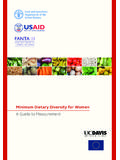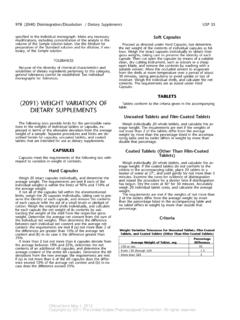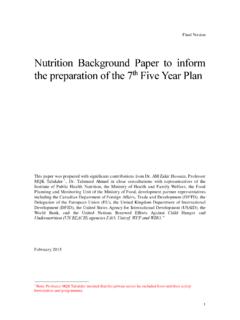Transcription of Millennium Development Goals (MDGs) - …
1 MMiilllleennnniiuumm DDeevveellooppmmeenntt GGooaallss ((MMDDGGss)) Goals and Targets(from the Millennium Declaration)Indicators for monitoring progressGoal 1: Eradicate extreme poverty and hungerTarget 1: Halve, between 1990 and 2015, theproportion of people whose income isless than one dollar a day1. Proportion of population below $1 (PPP) per daya2. Poverty gap ratio [incidence x depth of poverty]3. Share of poorest quintile in national consumptionTarget 2: Halve, between 1990 and 2015, theproportion of people who suffer fromhunger4. Prevalence of underweight children under-five years of age5. Proportion of population below minimum level of dietaryenergy consumptionGoal 2: Achieve universal primary educationTarget 3: Ensure that, by 2015, childreneverywhere, boys and girls alike, will beable to complete a full course of primaryschooling6.
2 Net enrolment ratio in primary education7. Proportion of pupils starting grade 1 who reach grade 58. Literacy rate of 15-24 year-oldsGoal 3: Promote gender equality and empower womenTarget 4: Eliminate gender disparity in primary andsecondary education preferably by 2005and to all levels of education no laterthan 20159. Ratios of girls to boys in primary, secondary and tertiaryeducation10. Ratio of literate females to males of 15-24 year-olds11. Share of women in wage employment in the non-agricultural sector12. Proportion of seats held by women in national parliamentGoal 4: Reduce child mortalityTarget 5: Reduce by two-thirds, between 1990 and2015, the under-five mortality rate13.
3 Under-five mortality rate14. Infant mortality rate15. Proportion of 1 year-old children immunised againstmeaslesGoal 5: Improve maternal healthTarget 6: Reduce by three-quarters, between 1990and 2015, the maternal mortality ratio16. Maternal mortality ratio17. Proportion of births attended by skilled health personnelGoal 6: Combat HIV/AIDS, malaria and other diseasesTarget 7: Have halted by 2015 and begun toreverse the spread of HIV/AIDS18. HIV prevalence among 15-24 year old pregnant women19. Condom use rate of the contraceptive prevalence rateb20. Number of children orphaned by HIV/AIDScTarget 8: Have halted by 2015 and begun toreverse the incidence of malaria andother major diseases21.
4 Prevalence and death rates associated with malaria22. Proportion of population in malaria risk areas usingeffective malaria prevention and treatment measuresd23. Prevalence and death rates associated with tuberculosis24. Proportion of tuberculosis cases detected and cured underdirectly observed treatment short course (DOTS)Goal 7: Ensure environmental sustainabilityTarget 9: Integrate the principles of sustainabledevelopment into country policies andprogrammes and reverse the loss ofenvironmental resources25. Proportion of land area covered by forest26. Ratio of area protected to maintain biological diversity tosurface area27. Energy use (kg oil equivalent) per $1 GDP (PPP)28.
5 Carbon dioxide emissions (per capita) and consumption ofozone-depleting CFCs (ODP tons)29. Proportion of population using solid fuelsTarget 10: Halve, by 2015, the proportion of peoplewithout sustainable access to safedrinking water30. Proportion of population with sustainable access to animproved water source, urban and ruralTarget 11By 2020, to have achieved a significantimprovement in the lives of at least 100million slum dwellers31. Proportion of urban population with access to improvedsanitation32. Proportion of households with access to secure tenure(owned or rented)Goal 8: Develop a global partnership for developmentTarget 12: Develop further an open, rule-based,predictable, non-discriminatory tradingand financial systemIncludes a commitment to good governance, Development , and poverty reduction bothnationally and internationallyTarget 13: Address the special needs of the leastdeveloped countriesIncludes: tariff and quota free access for leastdeveloped countries' exports; enhancedprogramme of debt relief for HIPC andcancellation of official bilateral debt.
6 And moregenerous ODA for countries committed topoverty reductionTarget 14:Address the special needs of landlockedcountries and small island developingStates(through the Programme of Action for theSustainable Development of Small IslandDeveloping States and the outcome of thetwenty-second special session of the GeneralAssembly)Target 15:Deal comprehensively with the debtproblems of developing countriesthrough national and internationalmeasures in order to make debtsustainable in the long termSome of the indicators listed below are monitoredseparately for the least developed countries (LDCs), Africa,landlocked countries and small island developing Development assistance33. Net ODA, total and to LDCs, as percentage of OECD/DACdonors gross national income34.
7 Proportion of total bilateral, sector-allocable ODA ofOECD/DAC donors to basic social services (basiceducation, primary health care, nutrition, safe water andsanitation)35. Proportion of bilateral ODA of OECD/DAC donors that isuntied36. ODA received in landlocked countries as proportion of theirGNIs37. ODA received in small island developing States asproportion of their GNIsMarket access38. Proportion of total developed country imports (by value andexcluding arms) from developing countries and LDCs,admitted free of duties39. Average tariffs imposed by developed countries onagricultural products and textiles and clothing fromdeveloping countries40. Agricultural support estimate for OECD countries aspercentage of their GDP41.
8 Proportion of ODA provided to help build trade capacityeDebt sustainability42. Total number of countries that have reached their HIPC decision points and number that have reached their HIPC completion points (cumulative)43. Debt relief committed under HIPC initiative, US$44. Debt service as a percentage of exports of goods andservicesTarget 16:In co-operation with developingcountries, develop and implementstrategies for decent and productivework for youth45. Unemployment rate of 15-24 year-olds, each sex and totalfTarget 17:In co-operation with pharmaceuticalcompanies, provide access to affordable,essential drugs in developing countries46. Proportion of population with access to affordable essentialdrugs on a sustainable basisTarget 18:In co-operation with the private sector,make available the benefits of newtechnologies, especially information andcommunications47.
9 Telephone lines and cellular subscribers per 100population48. Personal computers in use per 100 population andInternet users per 100 populationThe Millennium Development Goals and targets come from the Millennium Declaration signed by 189 countries,including 147 Heads of State, in September 2000 ( - A/RES/55/2).The Goals and targets are inter-related and should be seen as a whole. They represent a partnership between thedeveloped countries and the developing countries determined, as the Declaration states, to create an environment at the national and global levels alike which is conducive to Development and the elimination of poverty. a For monitoring country poverty trends, indicators based on national poverty lines should be used, where Amongst contraceptive methods, only condoms are effective in preventing HIV transmission.
10 The contraceptive prevalence rate is alsouseful in tracking progress in other health, gender and poverty Goals . Because the condom use rate is only measured amongst womenin union, it will be supplemented by an indicator on condom use in high risk situations. These indicators will be augmented with anindicator of knowledge and misconceptions regarding HIV/AIDS by 15-24 year-olds (UNICEF WHO).c To be measured by the ratio of proportion of orphans to non-orphans aged 10-14 who are attending Prevention to be measured by the % of under 5s sleeping under insecticide treated bednets; treatment to be measured by % of under5s who are appropriately OECD and WTO are collecting data that will be available for 2001 An improved measure of the target is under Development by ILO for future years.






